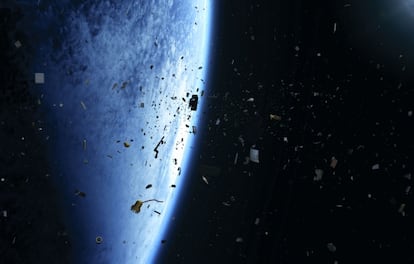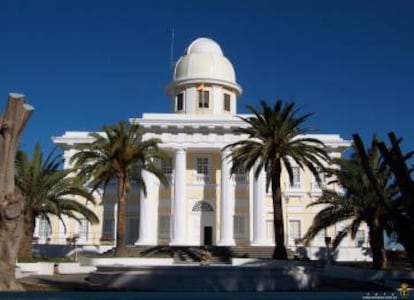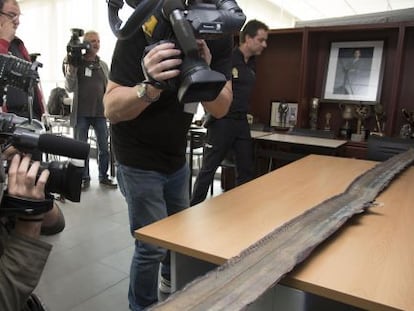The Spanish observatory tracking space junk with lasers
Cádiz-based institution will play key role in EU initiative to deal with debris in Earth’s orbit

Spain’s Royal Navy Institute and Observatory (ROA) is playing a key role in an EU initiative to monitor the millions of pieces of space junk orbiting the Earth and prevent them from colliding with satellites or the International Space Station (ISS).
“Only 7% of what is up there are functioning satellites,” says José Martín Davila, the Galician-born director of ROA, in the southern Spanish city of Cádiz. “There are around 30,000 particles that are more than 10 centimeters across, around 700,000 between 10 centimeters and one centimeter, and millions that are less than a centimeter long,” he adds.
The more debris is catalogued and its orbit tracked, the easier it will be to prevent accidents
The observatory is one of just a few in the world able to track such tiny fragments, which can cause huge damage. Using laser technology, around 20,000 pieces of space debris have so far been located and their orbit tracked.
The ROA says that space junk represents a threat to densely populated areas of the planet such as Western Europe. Late last year, four titanium balls each weighing around 17 kilograms and with a diameter of approximately 65 centimeters fell over southeastern Spain, fortunately away from populated areas. The US Air Force, which wants them back, says they belonged to the Atlas V rocket.
“This is an important issue. But nobody has wanted to deal with it because some countries, like China, preferred to ignore it,” says Martín Davila. He says that the EU, which is contributing to the cost of updating the ROA, wants a “giant eye made up of many smaller ones” to protect Europe. The more debris is catalogued and its orbit tracked, the easier it will be to prevent accidents with functioning satellites or particles falling to Earth.
Aside from the observatory in Cádiz, Spain has a telescope in the Pyrenees that photographs the sky to calculate the position of objects orbiting the Earth. The ROA is also able to correct the orbit of satellites fitted with retroreflectors, mirrors that reflect back light to its point of origin.

Founded in the late 18th century, Spain’s Royal Observatory served (and continues to serve) the same purpose as the Greenwich Observatory in Britain – providing an accurate source of time for the Navy and the country. But unlike Greenwich, the ROA is on a restricted-access military base and is not open to the public. It has a staff of approximately 90 people ranging from groundsmen to scientists. Around 35% are military and the rest civilians.
English version by Nick Lyne.
Tu suscripción se está usando en otro dispositivo
¿Quieres añadir otro usuario a tu suscripción?
Si continúas leyendo en este dispositivo, no se podrá leer en el otro.
FlechaTu suscripción se está usando en otro dispositivo y solo puedes acceder a EL PAÍS desde un dispositivo a la vez.
Si quieres compartir tu cuenta, cambia tu suscripción a la modalidad Premium, así podrás añadir otro usuario. Cada uno accederá con su propia cuenta de email, lo que os permitirá personalizar vuestra experiencia en EL PAÍS.
¿Tienes una suscripción de empresa? Accede aquí para contratar más cuentas.
En el caso de no saber quién está usando tu cuenta, te recomendamos cambiar tu contraseña aquí.
Si decides continuar compartiendo tu cuenta, este mensaje se mostrará en tu dispositivo y en el de la otra persona que está usando tu cuenta de forma indefinida, afectando a tu experiencia de lectura. Puedes consultar aquí los términos y condiciones de la suscripción digital.
More information
Últimas noticias
The complicated life of Francesca Albanese: A rising figure in Italy but barred from every bank by Trump’s sanctions
Pinochet’s victims grapple with José Antonio Kast’s rise in Chile
Reinhard Genzel, Nobel laureate in physics: ‘One-minute videos will never give you the truth’
Half of Scotland is in the hands of 420 property owners
Most viewed
- Pablo Escobar’s hippos: A serious environmental problem, 40 years on
- Reinhard Genzel, Nobel laureate in physics: ‘One-minute videos will never give you the truth’
- Why we lost the habit of sleeping in two segments and how that changed our sense of time
- Charles Dubouloz, mountaineering star, retires at 36 with a farewell tour inspired by Walter Bonatti
- The Florida Keys tourist paradise is besieged by immigration agents: ‘We’ve never seen anything like this’










































